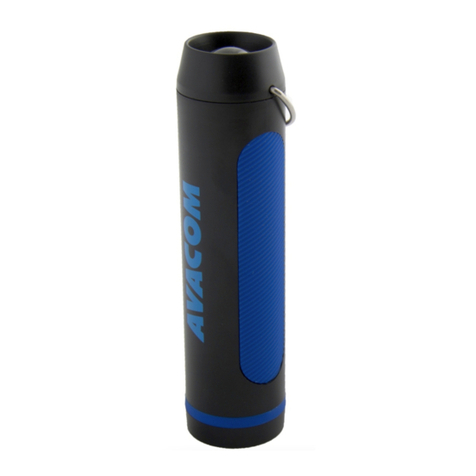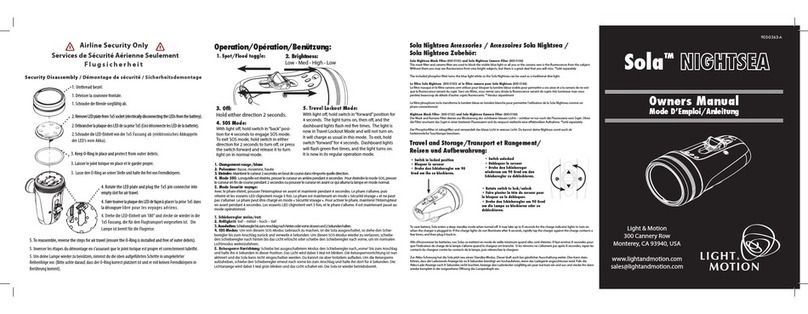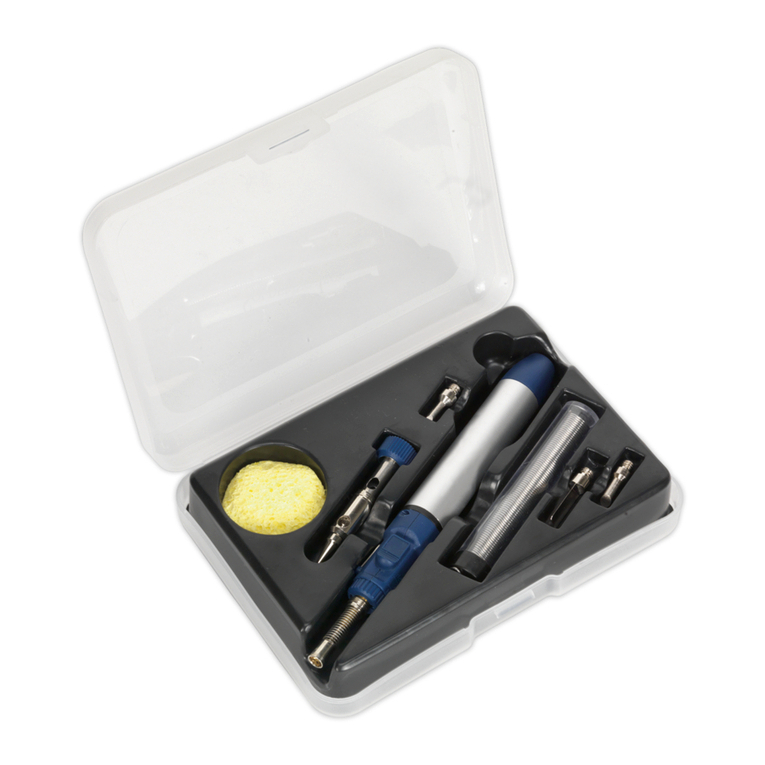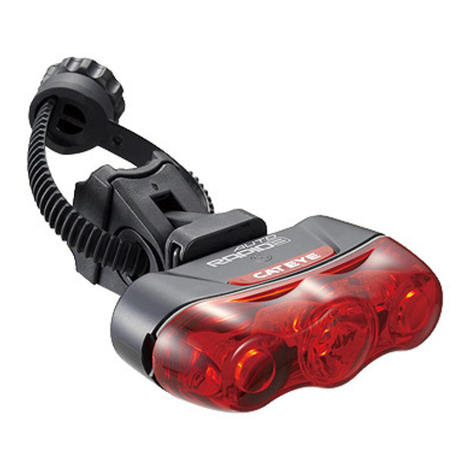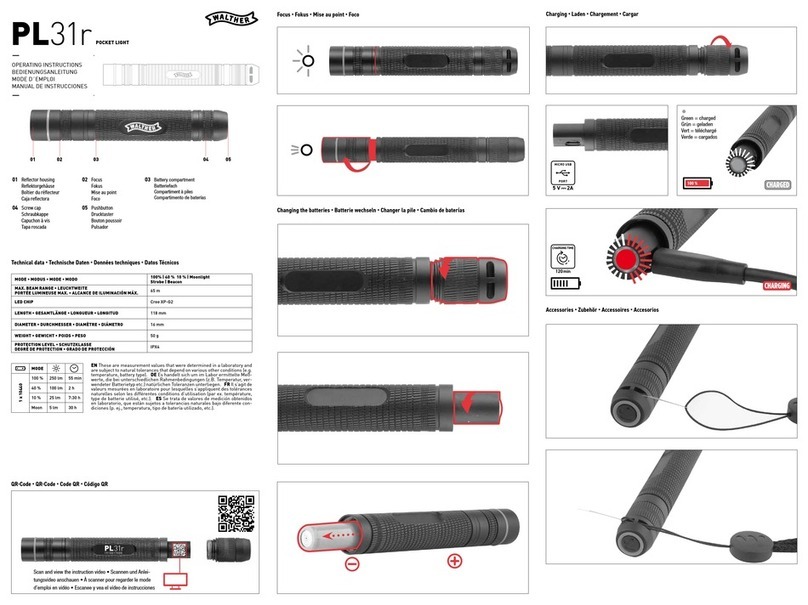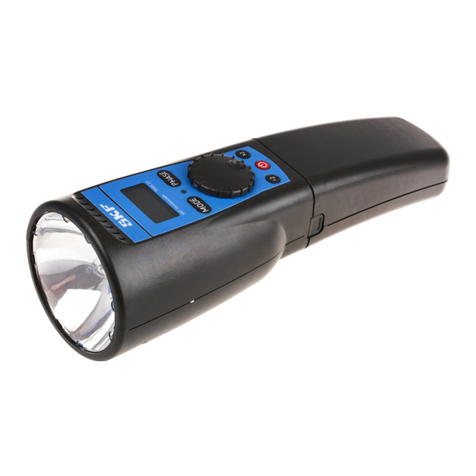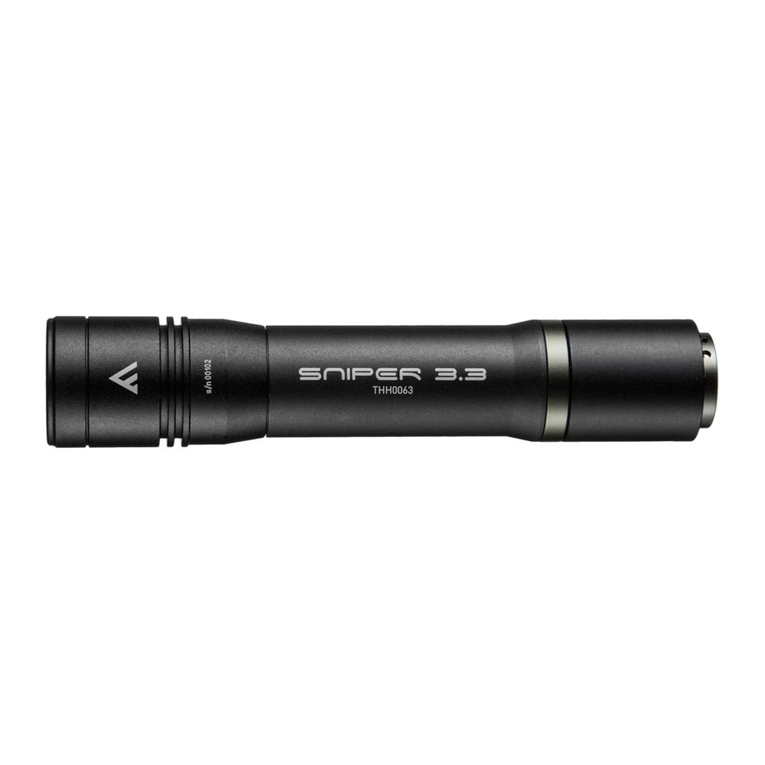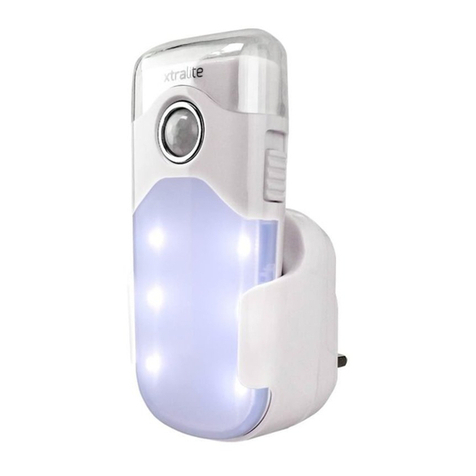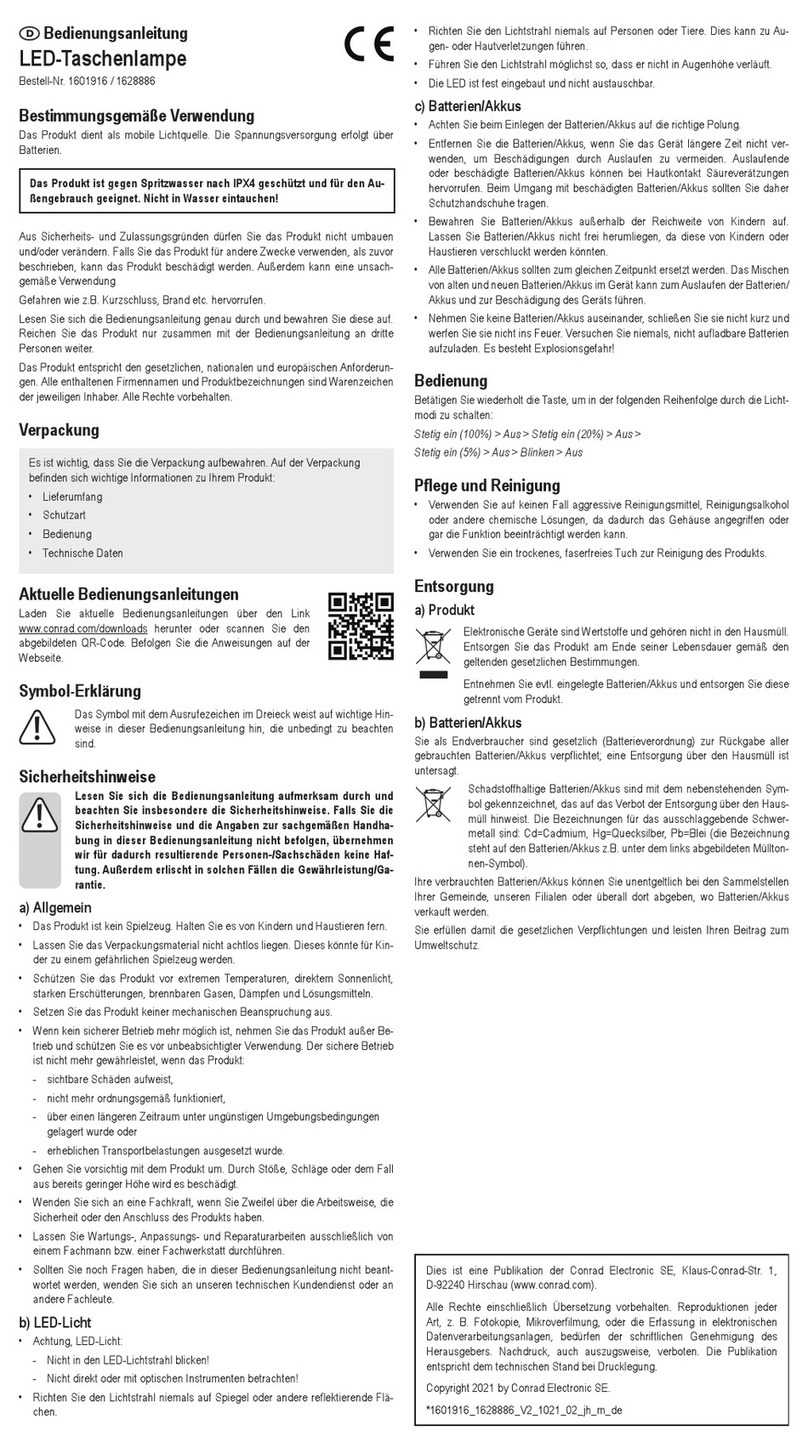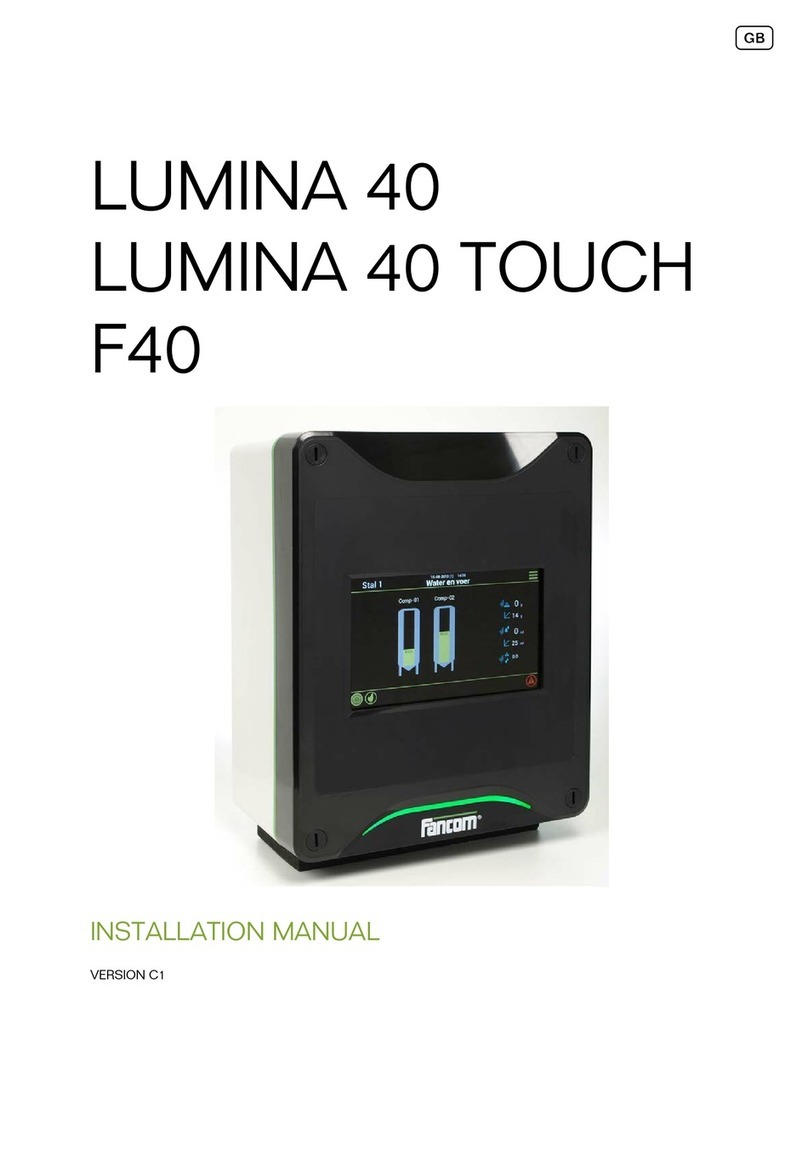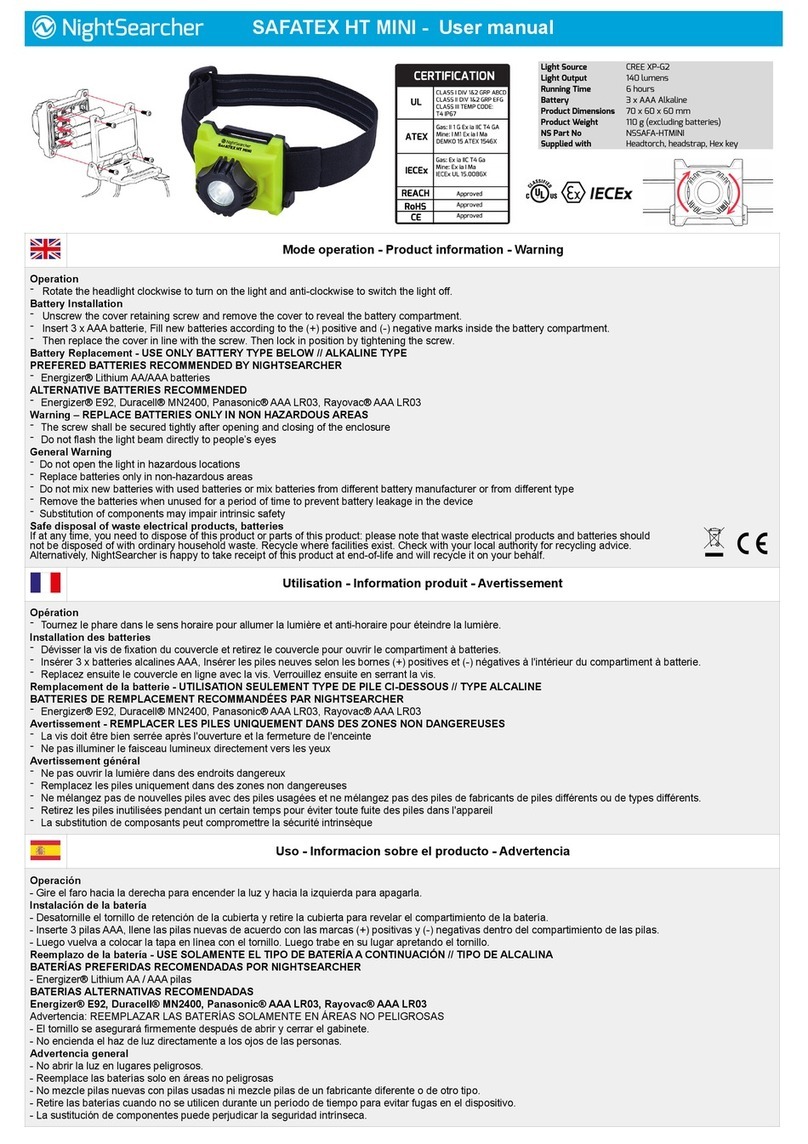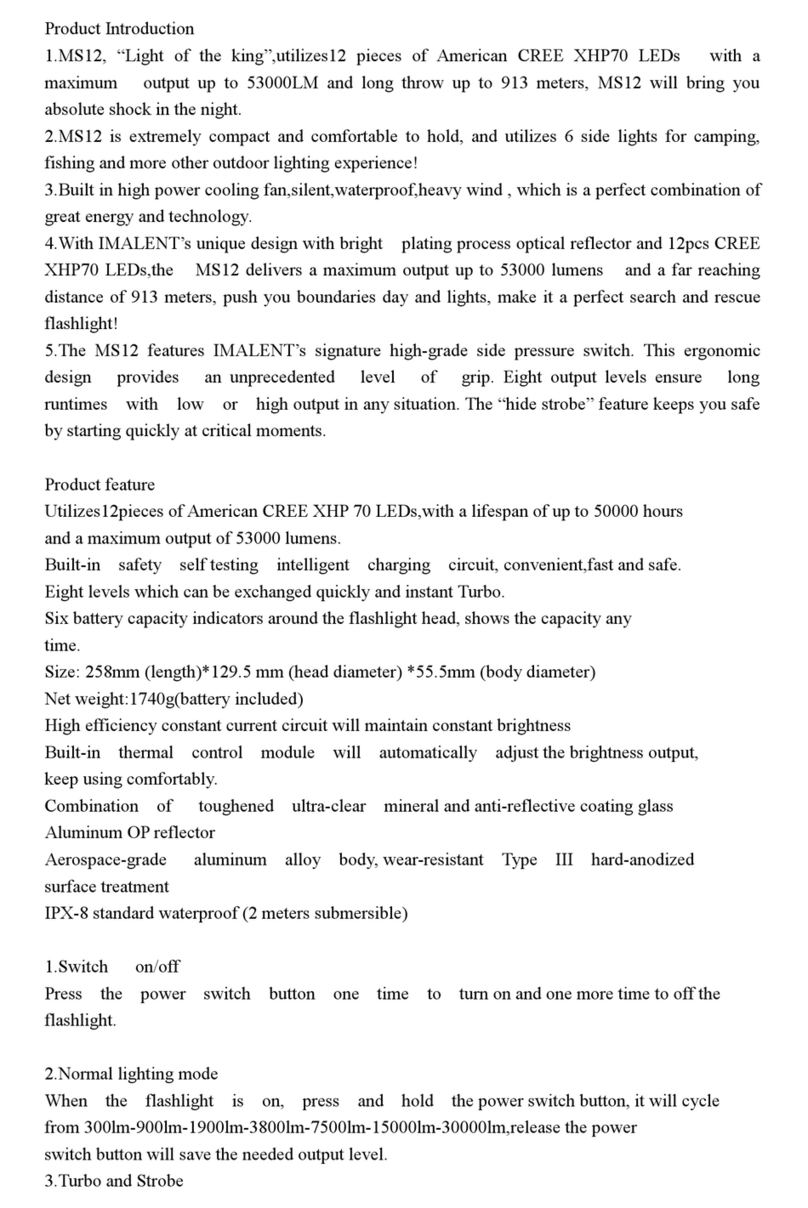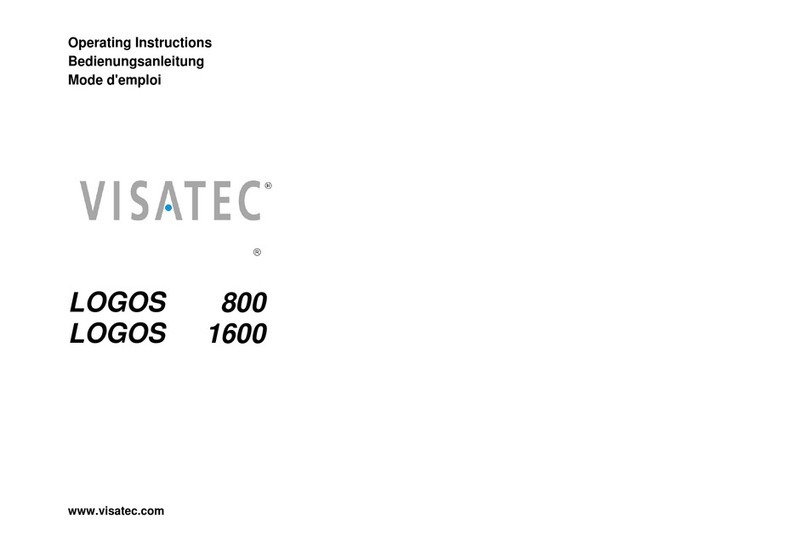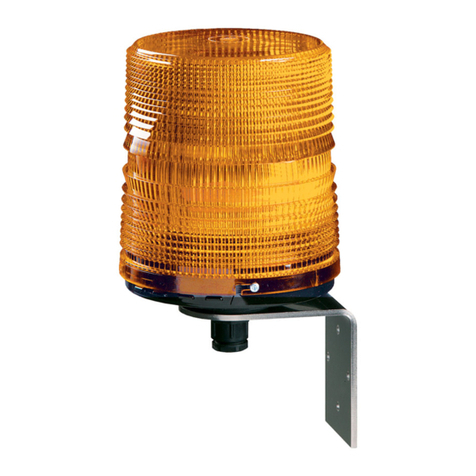Heinrich König REPAIRLUX 403 070 User manual

Heinrich König & Co. KG | An der Rosenhelle 5 | D-61138 Niederdorfelden | Fon +49 (0) 6101. 53 60-0 | www.heinrich-koenig.de
REPAIRLUX® COMPACT LIGHT
403 070
REPAIRLUX® COMPACT LIGHTEN
REPAIRLUX® COMPACT LIGHT
FR
REPAIRLUX® COMPACT LIGHT
ES
REPAIRLUX® COMPACT LIGHT
IT
REPAIRLUX® COMPACT LIGHT
NL

EINSATZBEREICH | USES
FürdieAushärtungvonMaterialienmitsichtbaremLicht.Die REPAIRLUX®Com-
pact Light wird exklusiv für Heinrich König & Co. KG hergestellt und darf nur für
die Aushärtung lichthärtender Füllstoe verwendet werden.
For the curing of materials with visible light.The REPAIRLUX® Compact Light is
manufacturedexclusivelyforHeinrichKönig&Co.KGandmayonlybeusedtocure
light-curing lling materials.
Pourlapolymérisationsouslumièrevisible.LaREPAIRLUX®CompactLightest fab-
riquée en exclusivité pourHeinrich König & Co. KG etdoit être utilisée uniquement
pour la polymérisation de charges photodurcissables.
Para materiales de curado mediante luz visible. La REPAIRLUX® Compact Light se
fabrica exclusivamente para Heinrich König & Co. KG y solo se puede utilizar para
curar materiales de obturación fotopolimerizables.
Voor uithardende materialen met zichtbaar licht. De REPAIRLUX® Compact Light
wordt exclusief voor Heinrich König geproduceerd en mag alleen voor uitharding
van lichtuithardende vulstoen worden gebruikt.
Perindurimentodimaterialiconlucevisibile.LaREPAIRLUX® Compact Lightèrea-
lizzataesclusivamenteperHeinrichKönig&Co.KGepuòessereutilizzatasolamente
per l‘indurimento di stucchi fotoindurenti.
Batteriewechsel
empfohlen nach
30 Anwendungen.
Einfach nach jeder
Anwendung abhaken:
It is recommended
to change batteries
after 30 uses.
Just tick o after
each use:
Remplacement des
piles recommandé
après 30 utilisations.
Simplement
cocher après chaque
utilisation:
Recomendamos
reemplazar las pilas
después de 30 usos.
Simplemente marque
la casilla correspon-
diente después de
cada uso:
Batterijwissel
aanbevolen na 30x
de lamp gebruikt te
hebben.
Na ieder gebruik
controleren:
Sostituzione batterie
consigliabile dopo
30 impieghi. Potete
segnare qui dopo ogni
utilizzo:
1
7
13
19
25
2
8
14
20
26
3
9
15
21
27
4
10
16
22
28
5
11
17
23
29
6
12
18
24
30
1
1
7
7
13
13
19
19
25
25
2
2
8
8
14
14
20
20
26
26
3
3
9
9
15
15
21
21
27
27
4
4
10
10
16
16
22
22
28
28
5
5
11
11
17
17
23
23
29
29
6
6
12
12
18
18
24
24
30
30
1
2
3
4
5
6
7
8
9
10
11
12
13
14
15
16
17
18
19
20
21
22
23
24
30
25
26
27
28
29
HINWEISE ZUR LAMPE | NOTES ON THE COMPACT LIGHT
Technische Daten: Länge: 155 mm, Gewicht:
165g.DieLampewirdohneBatteriengeliefert.
VerwendenSienur3xAAA1.5VBatterien.Neue
Batterien reichen für ca. 30 Anwendungen
à 3 Minuten. Danach ist keine ausreichende
Leistungmehrgegeben.Sicherheitshinweis:
Nicht direkt ins Licht sehen.
Betriebsanleitung: Setzen Sie3x1.5VGrößeAAA BatterienindasBatteriefacheinundschließenwieder
den Deckel (Bild 1 und 2). Betätigen Sie den schwarzen Druckknopf zum Ein- und wieder Ausschalten der
Compact Light (Bild 3). Stellen Sie die Compact Light immer vollständig auf die zu härtende Stelle auf.
Härtezeit bei Natur- und Kunststein ca. 3 Minuten pro cm².
Technical Data: Length: 155 mm, Weight:
165 g. The lamp is supplied without batteries.
Please use 3x AAA 1.5V batteries. You will be
able to achieve 30 x 3 minute cures with a set
of batteries. After this, the performance of
the light is insucient to cure the ller and
the batteries will need to be replaced. Safety
Instruction:Donotlookdirectlyintothelight.
Operating Instructions: Insert 3xAAA 1.5Valkaline batteriesinto the battery compartment and re-in-
stall the cover. Press the black button to switch the Compact Light on and o. Always place the Compact
Light completely over the area to be cured. Curing time for Natural Stone approx. 3 minutes per cm².
Donnéestechniques:longeur155mm,poids
165 g. La lampe est livrée sans piles. N‘utiliser
que des piles 3x AAA 1,5V. Les nouvelles piles
permettent environ 30 utilisations de 3 mi-
nutes.D‘aprèscela,leurperformancen‘estplus
susante. Conseil de sécurité: Ne regarder
jamais directement dans la source de lumière.
Instructions d‘utilisation: Insérer 3 piles AAA 1,5V dans le compartiment piles et refermer le couvercle
(voir images 1 et 2). Appuyer sur le bouton-poussoir noir pour la mise en marche et l‘arrêt de la lampe
compacte (voir image 3). Poser la lampe compacte toujours complètement sur l‘endroit à durcir. Temps
de durcissement pour la pierre naturelle environ 3 minutes par cm².
Ficha Técnica: Largo: 155mm, Peso: 165 g.
La lámpara se suministra sin pilas. Por favor,
use 3 pilas AAA de 1,5V. Con un conjunto de
pilas nuevas, se podrán realizar 30 curados de
3 minutos. Después de este tiempo, el ren-
dimiento de la lámpara no es suciente para
curar la masilla y las pilas han de ser reempla-
zadas. Instrucciones de Seguridad: No mire
directamente a la luz.
Manual de Instrucciones: Coloque 3 pilas alcalinas AAA de 1,5V en el compartimento para pilas y co-
loque la tapa. Pulse el botón negro de la Lámpara Compacta para encender y apagar. Coloque siempre
la Lámpara Compacta sobre la supercie total a curar. Tiempo de curado aprox. para piedra natural: 3
minutos por cm2.
Specificaties: lengte: 155 mm., gewicht: 165
gr. De lamp wordt zonder batterijen geleverd.
Gebruik alleen 3x AAA 1.5V batterijen. Nieu-
we batterijen kan men ca. 30 keer à 3 minu-
ten gebruiken. Daarna zijn de prestaties niet
meer optimaal. Veiligheid: niet direct in het
licht kijken.
Gebruiksaanwijzing: Plaats de 3x 1.5V AAA batterijen in het batterijvak en sluit de kap (foto 1 en 2).
Druk op de zwarte drukknop voor het aan- en weer uitzetten van de compact light (foto 3). 3. Altijd
de compact light helemaal op de te uit te harden plaats zetten. Uithardingstijd bij natuursteen ca. 3
minuten per cm².
Dati tecnici: Lunghezza: 155 mm, Peso: 165
g. La lampada viene fornita senza batterie.
Utilizzare solo 3 batterie da 1,5 V (AAA). Le
batterie nuove hanno un’autonomia di cir-
ca 30 cicli di utilizzo da 3 minuti ciascuno.
Dopodiché la potenza non è più suciente.
Avvertenze di sicurezza: Non guardare di-
rettamente la luce.
Istruzioni per l’uso: Inserite 3 batterie da 1,5 V (AAA) nell’apposito vano e richiudete il coperchio (foto 1
e 2). La lampada “Compact Light” viene accesa e spenta tramite il tasto nero (foto 3). Appoggiate la lam-
pada “Compact Light” sempre completamente sul punto da trattare. Tempo di indurimento per pietra
naturale: circa 3 minuti per ogni cm2.
EN
FR
ES
NL
IT
DE
ENDE FR ES ITNL
403070 Repairlux® CompactLigt | Stand 21/17

BETRIEBSHINWEISE | OPERATING NOTES
DE COMPACT LIGHT
455nm - Batteriebetrieben
DieLampeist für den folgendenAnwendungszweckbestimmt:Aushärtungvon Materialienmit
sichtbarem Licht. Die Lampe wird exklusiv für Heinrich König & Co. KG hergestellt und darf nur
für die Aushärtung lichthärtender Füllstoe verwendet werden.
BEDIENUNG, WARTUNG UND ARBEITSSICHERHEIT
Gefahrengruppe 2
Achtung – Gesundheitsgefährdende Strahlenbelastung durch dieses Produkt möglich
Betrieb und Wartung darf nur durch entsprechend qualiziertes und geschultes Personal
durchgeführt werden.ZurVermeidungvon Unfällen und Erkrankungenmüssen Anwenderund
Wartungspersonal VOR der erstenAnwendung bzw.Wartungdie Anleitung gründlichlesenund
die darin enthaltenenWarnhinweise befolgen.
Diese Anleitung muss allen Anwendern und demWartungspersonal jederzeit zurVerfügung
stehen.Vorzugsweisesollte sichdieAnleitung in der NähedesAnwendungsbereichesbenden.
ARBEITSSCHUTZ
EXPOSITION GEGENÜBER SICHTBARER STRAHLUNG
ÜbermäßigeExposition gegenüber sichtbarer Strahlung kannGesundheitsschäden verursachen,
wie z.B. Hautverbrennungen und Netzhautschädigungen.
Die Lampe ist eingestuft in die Risikoklasse 2 – geringes Risiko, gemäß BS EN 62471 : 2008
Fotobiologische Sicherheit von Lampen und Lampensystemen.
Diesbedeutet,dassdieLampe innerhalb 0,25 Sekunden (Schrecksituation)wederBlaulichtnoch
thermisch Netzhaut gefährdend ist. Das Risiko von Gesundheitsschädigungen reduziert sich
mit zunehmender Entfernung, z.B. beträgt die Entfernung, bei der die Lampe in Risikogruppe
1 eingestuft würde, 1,23 Meter und eine Einstufung in keinerlei Risikogruppe würde bei einer
Entfernungvon9,3Meter erfolgen.Die Exposition gegenüber sichtbaremLicht am Arbeitsplatz
unterliegt der Arbeitsschutzverordnung zu künstlicher optischer Strahlung 2010, welche am
27. April 2010 die Richtlinie 2006/25/EG über künstliche optische Strahlung in Kraft gebracht
hat. Diese enthält gesetzlich vorgeschriebene Expositionsgrenzwerte, die auf jene basieren,
die von der Internationalen Kommission zum Schutz vor nichtionisierender Strahlung festge-
legt wurden.Wenn Personen sichtbarem Licht aus künstlichen Quellen ausgesetzt sind, muss
überprüft werden, wie hoch das Risiko von Gesundheitsschädigungen ist und der persönliche
Lichtexpositionswertermittelt undmitden Expositionsgrenzwerten verglichenwerden.Woder
persönlicheExpositionswertmit den Expositionsgrenzwerten übereinstimmt,soweitpraktisch
durchführbar, kann das Risiko für die Mehrheit der Bevölkerung als niedrig und hinreichend
kontrolliertbetrachtetwerden.WoderpersönlicheExpositionswertdie Expositionsgrenzwerte
übersteigt, müssen zusätzliche Kontrollmaßnahmen durchgeführt werden, die die Exposition
bis unter die Expositionsgrenzwerte verringert.
KONTROLLMASSNAHMEN
Zielistessicherzustellen,dassbeikeinerPersondieExpositionsgrenzwertegegenüber sichtbaremLicht
für die ungeschützte Haut und die Augen überschritten werden. Dies kann durch eine Kombination
derfolgendenKontrollmethodenerreichtwerden:administrativeundpersönliche Schutzausrüstung.
Besondere Bedeutung sollte auf administrative Kontrollmaßnahmen gelegt wer-
den, um die Notwendigkeit einer persönlichen Schutzausrüstung einzuschränken.
ADMINISTRATIVE KONTROLLMASSNAHMEN
a) GEFAHRENBEWUSSTSTEIN:Der Anwender sollte den sichtbaren Lichtstrahl immer vom
Körper weg halten und niemals direkt auf die ungeschützte Haut oder die Augen einer ande-
ren Person leuchten. Alle Personen, die sichtbarem Licht ausgesetzt sein könnten, welches die
Expositionsgrenzwerteüberschreitet,müssen ausreichendeInformationen, Anweisungenund
Unterweisungenerhalten, um die damitverbundenenRisiken für ihreGesundheit zu erkennen
und in der Lage sein, Vorkehrungen zu treen, um mit dem Risiko angemessen umgehen zu
können. Personen, die ungewöhnliche Reaktionen oder Gesundheitsschäden feststellen, die
aufdie Exposition vonsichtbaremLichtzurückgehenkönnten,sollten zuersteineentsprechend
qualizierte Person zu Rate ziehen, bevor sie weiter exponiert werden.
b) Einhalten der Expositionsgrenzwerte des sichtbaren Lichts gegenüber unge-
schützter Haut und Augen gemäß den Kontrollvorschriften für künstliche optische
Strahlung am Arbeitsplatz 2010. Die Expositionsgrenzwerte des sichtbaren Lichts liegen
unter dem Grenzwert sichtbaren Lichts,bei dem erkennbare Gesundheitsschäden auftreten
können und erheblicheSicherheitsabstände erfordern.Wenn der Grenzwert für die zulässige
Höchstexposition überschritten wird, muss die Bestrahlungsstärke des sichtbaren Lichts durch
geeignete Schutzmaßnahmen reduziert werden. Diese könnten sein, größerer Abstand zur
Lichtquelle,Verkürzungdes Expositionszeitraums,Sicherheitsabdeckungoderals letztes Mittel
Bereitstellung einer persönlichen Schutzausrüstung.
REFLEKTIERTES SICHTBARES LICHT
Viele Oberächen, insbesondere glatte und/oder stark reektierende und/oder helle, sind oft
gute Lichtreektoren.
Hinweisschilder und -zeichen – sollten verwendet werden, um auf dasVorhandensein von
sichtbarem Licht hinzuweisen, welchem Personen in einem Maß ausgesetzt sein könnten, das
die Grenzwerte überschreitet.
PERSÖNLICHE SCHUTZAUSRÜSTUNG
Hautschutz– Die wirkungsvollsteMethode, die Hautvor sichtbaremLicht zu schützen,ist, siezu
bedecken.GefährdeteBereichesind fürgewöhnlich:Handrücken,Unterarme,Gesichtund Hals.
Alleanderen Bereichewerdenmeistensdurch Kleidungbedeckt.Die Hände könnendurchTragen
vonHandschuhen geschütztund Arme mitlangenÄrmeln bedeckt werden,derStosolltenurge-
ringlichtdurchlässigsein. Im Allgemeinen bietendunkle, schwereStoemit einer geschlossenen
Struktureinen höherenLichtschutz als helle,leichte Stoemit einer oenen Struktur.Das Gesicht
wirdmit einer455nm Gesichtschutzmaskegeschützt, dieebenfalls fürden Schutzder Augensorgt.
Augenschutz–Wir empfehlen,dortwodie persönliche Expositiongegenübersichtbarem Licht
erheblich sein, dass alle betroenen Personen immer 455nm Schutzbrillen tragen, um sich vor
einem eventuellen Restrisiko zu schützen.
EINSETZEN DER BATTERIEN
a) Lösen und Entfernen der Lampenrückseite
b) Entfernen der Batterietrommel
c) Einsetzen von 3x AAA Batterien in die Trommel (mit Minuspol an Feder)
d) Einsetzen der Batterietrommel (mit dem Pluspol zuerst)
e) Wiedereinsetzen der Lampenrückseite
BETRIEB
Vor dem Einschalten, bitte Folgendes beachten. Im Zweifelsfall nicht in Betrieb nehmen.
NIEMALS in Betrieb nehmen:
a) im Falle einer sichtbaren Beschädigung von Lampe oder Batterien.
b) ohne die notwendigen Kontrollmaßnahmen hinsichtlich Schutz vor Überschreitung der
Lichtexpositionsgrenzwerte.
EINSCHALTEN
Der Anwender sollte immer den sichtbaren Lichtstrahl vom Körper weg halten und niemals
auf die ungeschützte Haut oder Augen einer anderen Person leuchten. Zum Ein- und aus-
schalten benutzen Sie den Schalter auf der Rückseite der Lampe. Nach dem Einschalten,
erreicht die Lampe nahezu sofort ihre Höchstleistung. Die Lebensdauer der Lampe hängt
ab von der Anzahl der Ein/Aus-Schaltzyklen und von der Leistungsfähigkeit der verwen-
deten Batterien ab.
REINIGUNG DER GLASSCHEIBE
Um eine bestmögliche Leistung zu gewährleisten, halten Sie die Glasscheibe sauber.Wischen
Sie mit einem weichen, feuchten, fusselfreienTuch über das Glas.Verwenden Sie keine Seife,
Reinigungs- oder Scheuermittel.
TECHNISCHE DATEN
Daunsere Produkteständig weiterentwickeltwerden,behaltenwiruns das Recht vortechnische
Daten ohne vorherige Ankündigung zu ändern.
Sichtbare Lichtquelle 455nm Single-Chip LED
Aufheizzeit Sofort
Heißzündung Ja
Maße 155mmx50mmØ
Gewicht (einschl. Batterie) 200g (ca.)
Schutzart: IP64
Betriebstemperaturbereich: 5°C-40°C
Stromversorgung: 3x AAA Batterien
Lebensdauer: Abhängig von der Anzahl der Ein/Aus-Schaltzyklen und von der
Leistungsfähigkeit der verwendeten Batterien.
EN COMPACT LIGHT
455nm - Battery Operated
The lamp is designed for the following application purpose: curing materials with visible light.
The lamp is manufactured exclusively for Heinrich König & Co. KG and may only be used to cure
light-curing lling materials
OPERATING, MAINTENANCE AND HEALTH AND SAFETY MANUAL
Risk Group 2
Caution - possibly hazardous optical radiation emitted from this product
Operationandmaintenanceshouldonly beperformedby suitablyqualied andtrained personnel.
In order to help prevent accidents or illhealth all operators and maintenance personnel mustread
carefully, fully understand and follow all the instructions and warnings contained in this manual
BEFORE operation or maintenance for the rst time.
This manual should always be readily available to all operators and maintenance personnel. It
should be prominently located in the area of usage.
HEALTH AND SAFETY - VISIBLE LIGHT EXPOSURE
Overexposuretovisible lightcancauseadverse healtheects,suchas skinburns andretinaldamage
totheeye.Thistorchisclassied Risk Group2 –moderaterisk, inaccordancewith BSEN 62471: 2008
PhotobiologicalSafety of Lampsand LampSystems.Thismeansthatthistorchwill notposeeither
a retinal blue-light hazard or a retinal thermal hazard within 0.25 seconds, which is the aversion
response.The risk of adverse health eects is reduced with distance, for example, the distance at
whichthis torchwouldberegardedas Risk Group1is1.23 metresandthe distanceat whichit would
beregardedas exemptis9.3 metres.OccupationalvisiblelightexposureissubjecttotheControlof
Articial Optical Radiation atWork Regulations2010, which broughtinto law on27th April 2010 ,
the European Physical Agents (Articial Optical Radiation 2006/25/EC) Directive (AORD 2006/25/
EC).This incorporates statutory exposure limit values(ELVL’s) which are based onthose dened by
the International Commission on Non Ionising Radiation Protection (ICNIRP). In cases of persons
subjected to visible light emissions from articial sources, it is necessary to assess the level of risk
for adverse health eects by determining personal light exposure levels and comparing with the
exposure limit values. Where personal exposure levels comply with the exposure limit values, the
risk can be considered lowfor the majority of thepopulation and adequately controlled so faras is
reasonablypracticable.Wherepersonalexposureexceedsthe exposurelimitvalues,thenadditional
controlmeasuresmustbe implementedwhichdecreaseexposuretobelowtheexposurelimit values.
CONTROL MEASURES
The objective is to ensure that the visible light exposure limit values for the unprotected skin and
eyearenot exceededbyanyperson. Thiscanbe achievedbyacombinationof thefollowing control
methods: administrative and personal protective equipment.
Emphasis should be placed on administrative control measures to minimise the need
for personal protective equipment.
ADMINISTRATIVE CONTROL MEASURES
a) HAZARD AWARENESS: The operator should always point the visible light beam away from
their body and never shine directly at anyone’s unprotected skin or eyes.
Allpersonswhocouldbeexposedtolevelsofvisiblelightexceedingtheexposurelimitvaluesorsignif-
icantpersonalexposuremustbe providedwithsucient information,instruction andtraining toun-
derstandthe associatedrisksto theirhealth andthe precautionswhich shouldbe takentoadequately
managethe risk.Any personwho noticesanyunusualor adversereactionthought tobe dueto visible
lightexposureshouldnotbe further exposeduntil afterconsulting witha suitablyqualied person.
b) Compliancewith thevisible lightexposurelimitvalues forthe unprotectedskin and
eye in accordance with the Control of Articial Optical Radiation at Work Regulations
2010.Thevisiblelightexposurelimitvalues aresetbelowthresholdlevelsof lightexposurewhere
observable adverse health eects would occur and incorporate signicant safety margins.
If the maximum permissible exposure values are exceeded then the visible light irradiance must
be reduced by appropriate control measures. These could include moving further away from the
source, reducing exposure time, containment, or as a last resort provision of personal protective
equipment (PPE).
REFLECTED VISIBLE LIGHT
Many surfaces, especially those that are smooth and/or highly reective and/or light coloured,
are often good reectors of light.
Warning labels and signs – Should be used to indicate the presence of visible light which
could result in persons being exposed to levels exceeding the exposure limit values, or signicant
personal exposure.
PERSONAL PROTECTIVE EQUIPMENT
Protectionof the skin–Themost eectivewayto protectthe skinfromvisiblelightistocoverit.
The areas of skin usually at risk are the backs of the hands, forearms, face and neck, as other areas
are usually covered by clothing. The hands can be protected by wearing gloves and arms can be
covered by long sleeves, using material with low light transmission. In general, darker coloured,
heavier fabrics with a closed structure oer a higher level of protection than light coloured, light
weight fabricswith an open structure. The facecan be protectedby a 455 nmblocking face shield
and this will also provide eye protection.
Protection of the eyes –We recommend that where personal visible light exposure could be
signicant, all persons aected should always wear 455 nm blocking spectacles will ensure pro-
tection against any residual risk.
BATTERY FITTING
a) Unscrew and remove the rear of the torch.
b) Remove battery carriage
c) Insert 3 x AAA cells into battery carriage (negative end to spring)
d) Insert battery carriage positive end rst.
e) Replace rear of torch
OPERATION
Before switching on, always check the following. If in any doubt whatsoever do not switch on.
NEVER OPERATE:
a) If there is any visible damage to the torch or batteries.
b) Without the necessary control measures in place for protection against exceeding the visible
light exposure limit values.
SWITCHING ON
The operator should always point the visible light beam away from their body and never shine
directly at anyone’s unprotected skin or eyes. Switch on and o using the power switch on the
rear of the torch. Once switched on it will reach it’s optimum visible light output almost instantly.
The run time of the torch will depending upon the number of on/o switching cycles and the
capacity of the batteries used.
CLEANING OF FRONT GLASS
To ensure optimumperformance keep thefront glassclean. Wipe over thesurface of the front glass
witha soft, damp,lintfree cloth orAlcowipe.Neveruse anysoaps, detergentsor abrasivematerials.
TECHNICAL DATA
Due to our policy of continuous development, we reserve the right to amend technical data and
therefore information may be subject to change without prior notice.
Visible light source: 455nm Single Chip LED
Warm up: Instant
Hot restrike: Yes
Dimensions: 155mm x 50mmØ
Weight including battery: 200g (approx.)
Rating: IP64
Operating ambient temperature range: 5OC – 40OC
Power supply: 3 x AAA batteries
Running time: Depends on the number of on/o switching cycles
and capacity of the batteries.

BETRIEBSHINWEISE | OPERATING NOTES
FR COMPACT LIGHT
455 nm - Fonctionnement à piles
Cette lampe est destinée à l‘usage suivant : polymérisation sous lumière visible.
Lalampe estfabriquée enexclusivitépour HeinrichKönig&Co.KGetdoitêtreutilisée uniquement
pour la polymérisation de charges photodurcissables.
UTILISATION, ENTRETIEN ET SÉCURITÉ DU TRAVAIL
Groupe de risque 2
Attention : exposition dangereuse au rayonnement possible
Seul un personnel dûment qualié et formé est habilité à utiliser et entretenir cet appareil. An
d‘éviter tout accidentoumaladie,les utilisateurs etlepersonneld‘entretiendoivent lireattentive-
mentleprésentmoded‘emploiet respecterles consignesy énoncéesAVANTlapremièreutilisation
ou l‘entretien.
Le présent mode d‘emploi doit être à la disposition de l‘ensemble des utilisateurs et du personnel
d‘entretien à tout moment. Il doit se trouver de préférence à proximité du lieu d‘utilisation.
SÉCURITÉ DU TRAVAIL
EXPOSITION A LA LUMIERE VISIBLE
Une exposition excessive à la lumière visible peut entraîner des eets sur la santé, tels que des
brûlures cutanées et des dommages à la rétine. La lampe est classée dans le groupe de risque
2– risquemodéré,selonBS EN62471: 2008 Sécuritéphotobiologique deslampes et desappareils
utilisantdeslampes.Celasignie quela lampeneprésentepas derisque rétinienthermique oudû
àla lumièrebleuepour uneexposition de0,25 secondes(ponctuelle, parex.peur).Lerisque d‘eets
sur la santédiminue avecl‘éloignement :par ex. ladistance à laquelle lalampe serait classée dans
le groupe de risque 1 est de 1,23 mètre, et la distance à laquelle elle ne serait classée dans aucun
groupe est de 9,3 mètres. L’exposition aux rayonnements optiques articiels sur le lieu du travail
estsoumis audécret relatifàla protectiondes travailleurscontrelesrisquesdus auxrayonnements
optiques articiels 2010 ce quia donné force de loi ledécret 2006/25/EC relatif auxrayonnements
optiques articiels le 27 avril 2010. Celui-ci contient les niveaux d’exposition basés sur ceux xés
parla commissioninternationalepourla protection contrelesrayonnementsnon ionisants.En cas
d‘exposition àdesrayonnementsoptiquesarticiels,le niveaude risquedeseets surla santédoit
être vérié et l‘exposition individuell e à la lumière déterminée et comparée aux valeurs limites
d‘exposition. Lorsquelavaleurd‘expositionindividuelleest conformeauxvaleurslimitesd‘exposition,
dansla mesureduréalisable,le risque pourla majoritéde lapopulation peutêtreconsidérécomme
faibleet susammentcontrôlé.Lorsquelavaleur d‘expositionindividuelleest supérieureauxvaleurs
limitesd‘exposition,desmesures decontrôlesupplémentairesvisant àréduirel‘expositionde sorte
qu‘elle soit inférieure aux valeurs limites d‘exposition doivent être mises en œuvre
MESURES DE CONTROLE
L‘objectif est de garantir que les valeurs limites d‘exposition à la lumière visible pour la peau
non protégée et les yeux ne soient dépassées pour personne. Il peut être atteint grâce à la
combinaison des méthodes de contrôle suivantes : équipements de protection individuelle et
mesuresadministratives.Il convient d‘accorderuneimportance particulière aux mesures
de contrôle administratives an de limiter la nécessité du port d‘équipements de
protection individuelle.
MESURES DE CONTROLE ADMINISTRATIVES
A CONSCIENCEDESDANGERS: L‘utilisateurdoittoujours tenirle rayonnementvisible àdistance
du corps et ne jamais le diriger directement sur la peau non protégée ou dans les yeux.
Toutesles personnes susceptibles d‘être exposéesà la lumière visibledépassant les valeurslimites
d‘exposition doiventêtresusamment informées,instruiteset forméesan d‘identierlesrisques
inhérents pour leur santé et être en mesure de prendre les dispositions nécessaires pour éviter ces
risquesde manièreappropriée.Toutepersonneconstatantdesréactions inhabituellesou deseets
sur leur santépouvant être liés àl‘exposition àla lumière visibledoit en premierlieu consulter une
personne dûment qualiée avant d‘être de nouveau exposée.
b) Respect desvaleurs limitesd‘expositionà lalumièrevisible dela peaunonprotégée
et des yeux conformément aux prescriptions de contrôle des rayonnements optiques
articiels sur le lieu de travail 2010. Les valeurs limites d‘exposition de lalumière visible sont
inférieuresàlavaleur limitede la lumièrevisible pouvantentraînerdeseets notablessurla santé
qui exigent d‘importantes distances de sécurité. Si la valeur limite de l‘exposition maximale est
dépassée, l‘intensité durayonnement dela lumière visible doitêtre réduite au moyen de mesures
de protection appropriées telles qu‘une distance plus élevée par rapport à la source lumineuse,
une réduction du temps d‘exposition, un cache de sécurité ou, en dernier recours, la fourniture
d‘équipements de protection individuelle.
LUMIERE VISIBLE REFLECHIE
Denombreusessurfacessontsouventdebons réecteursdelumière,notamment lessurfaceslisses
et/ou fortement rééchissantes et/ou claires.
Il convient d‘utiliser des panneaux et des symboles d‘avertissement pour signaler la
présence de lumière visible à laquelle des personnes pourraient être exposées au-delà des
valeurs limites.
ÉQUIPEMENTS DE PROTECTION INDIVIDUELLE
Protection de la peau – La méthode la plus ecace pour protéger la peau de la lumière visible
est de la couvrir. Les zonesà risques habituelles sont: le dos des mains, les avant-bras,le visage et
le cou. Les autres zones sont généralement couvertes par les vêtements. Les mains peuvent être
protégées par le port de gants et les avant-bras couverts par des manches longues, le tissu ne
devant être que très peu perméable à la lumière. De manière générale, les tissus foncés, lourds
et présentant une structure fermée orent une protection contre la lumière supérieure aux tissus
clairs, légers et avec une structure fermée. Le visage est protégé à l‘aide d‘un masque de 455 nm
qui assure également la protection des yeux.
Protection des yeux – Nous recommandons le port systématique de lunettes de protection de
455 nm pour toutes les personnes concernées dans les lieux où l‘exposition individuelle peut être
importante an de se protéger de tout risque résiduel.
MISE EN PLACE DES PILES
a) Dévisser et retirer l‘arrière de la lampe.
b) Retirer le logement des piles
c) Placer 3 piles AAA dans le logement (pôle négatif contre le ressort)
d) Insérer le logement des piles dans la lampe (pôle positif en premier)
e) Revisser l‘arrière de la lampe
FONCTIONNEMENT
Avant toute activation, observer les points suivants. En cas de doute, ne jamais mettre la lampe
en marche.
NE JAMAIS mettre la lampe en marche :
a) en cas de dommage visible sur la lampe ou les piles ;
b) enl‘absencedes mesuresde contrôleindispensablesrelativesà laprotection contreledépas-
sement des valeurs limites d‘exposition.
ACTIVATION
L‘utilisateurdoittoujours tenirle rayonnementvisible àdistancedu corpset nejamais ledirigersur
la peau non protégée ou dans les yeux. Pour allumer ou éteindre la lampe, utiliser l‘interrupteur
situé à l‘arrière. Lors de l‘allumage, la lampe atteint sa puissance maximale presque immédiate-
ment. L‘autonomie de la lampe dépend du nombre de cycles d‘activation/désactivation et des
performances des piles utilisées.
NETTOYAGE DE LA LENTILLE
An de garantir une performance optimale, maintenir la lentille propre. Essuyer le verre avec un
chiondoux humideet nonpelucheux. Nepas utiliser desavon,de produitsnettoyantsouabrasifs.
CARACTÉRISTIQUES TECHNIQUES
Nos produitsfaisant l‘objet de mises au point constantes,nous nous réservons le droit de modier
les caractéristiques techniques sans préavis.
Source de lumière visible: LED monopuce 455 nm
Temps de mise à température: immédiat
Amorçage à chaud: oui
Dimensions: 155 mm x 50 mm Ø
Poids (avec piles): 200 g (env.)
Indice de protection: IP64
Plage de températures de service: 5 °C - 40 °C
Alimentation électrique: 3 piles AAA
Autonomie: dépenddunombredecyclesd‘activation/désactivationet des
performances des piles utilisées.
ES COMPACT LIGHT
455nm – a pilas
Lalámparaestá diseñadaparalossiguientesnesde aplicación:materialesde curadomedianteluz
visible. La lámpara se fabrica exclusivamente para Heinrich König & Co. KG y solo se puede utilizar
para curar materiales de obturación fotopolimerizables.
FUNCIONAMIENTO, MANTENIMIENTO Y MANUAL DE SALUD Y SEGURIDAD
Grupo de riesgo 2
Precaución – la radiación óptica emitida por este producto posiblemente es peligrosa.
Elfuncionamientoy mantenimientosólodeben serrealizadosporpersonaldebidamentecualicado
yformado.Conelnde preveniraccidentesoproblemasdesalud,todos lostrabajadoresy personal
demantenimientodebenleeratentamente,entenderyseguir todaslas instruccionesy advertencias
deestemanualANTESdeempezaratrabajarorealizartrabajos demantenimiento.Si ustedtiene al-
gunaduda conrespectoa lasinstruccionesoadvertencias,porfavorllame alteléfono 0121423 2000.
Este manual debe estar siempre visible para todos los trabajadores y personal de mantenimiento.
Debe estar situado y localizable en la zona de trabajo.
SALUD Y SEGURIDAD
EXPOSICICIÓN A LUZ VISIBLE
La exposición a la luz visible, puede causar efectos adversos en la salud, tales como quemaduras
en la piel, dañar el ojo y la retina. Esta linterna está clasicada como Grupo de Riesgo 2 – riesgo
moderado,de conformidadconlanorma BSEN 62471: 2008seguridadphotobiologica delámparas
y aparatos que utilizan lámparas. Esto signica que esta lámpara no supondrá peligro alguno por
luz azul o de retina térmica, peligros en los que la respuesta de aversión es de 0,25 segundos.
El riesgo de efectos adversos para la salud se reduce con la distancia, por ejemplo, la distancia a la
queesta lámparasería consideradacomogrupo deriesgo 1esde 1,23metrosy ladistanciaque sería
considerada como exenta es de 9,3 metros. La exposición a la luz visible en el trabajo está sujeta
a la Directiva sobre el Control de las Radiaciones Articiales en el Trabajo, que entró en vigor el 27
de abril del 2010,sobre Agentes Físicos(Radiación Óptica Articial 2006/25/CE) Directiva Europea
(2006/25/CE).Esta Directivaincorporalosvaloreslímitelegales(ELVL)basados enlos denidospor
la Comisión Internacional de Protección contra la Radiación No Ionizante (ICNIRP).
En los casos de personas sometidas a la emisión de luz visible a partir de fuentes articiales, es
necesarioevaluarel riesgode losposiblesefectos adversosparala saludmedianteladeterminación
delos nivelesdeexposiciónalaluz personalesy lacomparaciónconlos valoresdeexposición. Silos
valores deexposición personales cumplen conlos valoreslímite de exposición, elriesgo puede ser
considerado bajo para la mayoría de la población y controlar adecuadamente la medida en la que
sea razonablemente factible. Cuando los valores de exposición personales superan los límites de
exposición,entoncesdebenaplicarselas medidasde controladicionalespara disminuirla exposición
a valores por debajo de los límites de exposición.
MEDIDAS DE CONTROL
Elobjetivoes asegurarque losvaloreslímite deexposición ala luzvisiblesobrela pielsinprotección
yojos,no sesuperenporlas personas.Esto sepuede conseguircombinando lossiguientesmétodos
de control: administrativos y equipos de protección personal.
Se debe hacer énfasis sobre las medidas del control administrativo para de este modo
minimizar la necesidad de equipos de protección personal.
MEDIDAS DE COSNTROL ADMINISTRATIVAS
a) CONCIENCIA DE LOS PELIGROS: El trabajador siempre deberá enfocar hacia afuera el haz
de luz visible y nunca apuntar directamente sobre piel y ojos desprotegidos.Todas las personas
que puedan estar expuestas a niveles de luz visible superiores a los valores límites de exposición
personal, deben contar con suciente información, instrucción y formación para comprender los
riesgosasociadosala saludy lasprecaucionesque debenadoptarseparagestionar adecuadamente
el riesgo. Cualquier persona que note una reacción inusual o adversa y que crea que es debida a la
exposición de la luz visible, no debe exponerse por más tiempo hasta que pueda consultar a una
persona debidamente cualicada.
b) El cumplimiento de los valores límite de exposición a la luz visible sobre piel y ojos
desprotegidos, de acuerdo con el Control de Radiaciones Ópticas en el Trabajo Regla-
mento del 2010.Los valores límite de exposición a la luz visible se encuentran por debajo de los
niveles del umbral de exposición a la luz donde se podrían incorporar efectos de salud adversos
observables mediante importantes márgenesde seguridad. Silos valores límites de exposiciónse
sobrepasan, entonces se debe reducir la radiación de la luz visible hasta las medidas de control de
adecuadas.Estoscasos podríanseralejarse dela fuente,reducirel tiempode exposición,contención
o usar equipos de protección personal.
LUZ VISBLE REFLEJADA
Muchas supercies, especialmente las que son lisas y/o altamente reectantes y/o colores claros,
a menudo son buenos reectores de la luz.
Etiquetas de Advertencia y Signos – Se utilizan para indicar la presencia de luz visible que
podrían exponer a personas por encima de los valores límites de exposición o signicativos para
la exposición personal.
EQUIPOS DE PROTECCIÓN PERSONAL
Proteccióndelapiel –la formamás ecaz paraprotegerla pieles cubrirla.Lasáreasde lapielque
porlo generalestán ensituación deriesgo sonel dorsodelas manos,antebrazos,cara ycuelloyaque
las demás zona están normalmente cubiertas por ropa. Las manos se pueden proteger utilizando
guantesapropiadosy losbrazosutilizandomangas largas.Utilizarmaterialesque notransmitanla
luz.En general,lastelasmás pesadas,de coloresoscurosy conestructurascerradasofrecenniveles
de protección mucho más elevados que telas abiertas, claras y ligeras. La cara se puede proteger
utilizandoun 455nmPantallaProtectoraparala caraque asuvezproporcionaráprotecciónalos ojos.
Protección de los ojos – Se recomienda utilizar protección debido a que la exposición a la luz
visiblepodría ser importante,todas las personasdeben utilizar gafas deprotección455nm que les
proporcionará la protección ante cualquier riesgo residual.
COLOCACIÓN DE LAS PILAS
a) Desenroscar y quitar la parte trasera de la lámpara.
b) Retire la batería del carro.
c) Inserte 3 x AAA en el carro de la batería (polo negativo hacia el muelle)
d) Introduzca el polo positivo en primer lugar.
e) Reemplace la parte trasera de lámpara.
UTILIZACIÓN
Antes de empezar a utilizar la lámpara, compruebe siempre lo siguiente. En caso de alguna duda
no la encienda
NUNCA utilice
a) Si hay algún tipo de daño visible en la lámpara o sus pilas.
b) Sin las medidas de control necesarias para la protección contra el rebasamiento de los valores
límite de exposición a la luz.
ENCENDIDO
Eltrabajadorsiempredeberáenfocarhaciaafueraelhaz deluz visibley nuncaapuntardirectamente
sobre piel y ojos desprotegidos.
Encender y apagar con el interruptor de encendido que se encuentra en la parte posterior de la
lámpara.
Una vez encendida, la lámpara alcanzará su potencia de luz óptima casi al instante.
El tiempo de trabajo de la lámpara dependerá de la cantidad de veces que encienda y apague la
luz así como de la capacidad de las baterías usadas.
LIMPIEZA DEL CRISTAL FRONTAL
Para mantener un rendimiento óptimo mantener el cristal delantero siempre limpio. Pasar so-
bre el cristal delantero un paño suave y húmedo sin pelusa. Nunca utilice jabones, detergentes
o materiales abrasivos.
DATOS TÉCNICOS
Debidoa nuestrapolíticadedesarrollocontinuo,nos reservamoselderechode podermodicarlos
datos técnicos y por lo tanto, la información puede estar sujeta a cambios sin preaviso.
Fuente de luz visible: 455nm LED de chip único.
Calentamiento: Instantáneo.
Ignición caliente: Si
Dimensiones: 155mm x 50mm O
Peso incluyendo pilas: 200g (aprox.)
Clasicación: IP64
Rango de temperatura ambiente: 50C – 400C
Fuente de alimentación: 3 pilas AAA
Duración: Depende de los ciclos encendido/apagado
y de la capacidad de las baterías.

BETRIEBSHINWEISE | OPERATING NOTES
NL COMPACT LIGHT
455nm – werkt op batterijen
De lamp is bestemd voor de volgende doeleinden: uithardende materialen met zichtbaar licht.
De lamp wordt exclusief voor Heinrich König geproduceerd en mag alleen voor uitharding van
lichtuithardende vulstoen worden gebruikt.
BEDIENING, ONDERHOUD EN VEILIGHEID
Gevarenklasse 2
Let op - Gezondheidsgevaarlijke blootstelling van straling door dit product mogelijk.
Bediening en onderhoud mag alleen door gekwaliceerd en geschoold personeel worden uitge-
voerd.Om ongelukkenof ziektentevoorkomenmoeten gebruikerenonderhoudspersoneel VOOR
heteerstegebruikofonderhoudde instructies zorgvuldiglezenende waarschuwingendaarin vol-
gen.Dezeinstructiesdienen teallen tijdevoorallegebruikersen onderhoudspersoneelbeschikbaar
tezijn.Bijvoorkeurmoetende instructies indenabijheid vanhettoepassingsgebiedtevinden zijn.
VEILIGHEID
BLOOTSTELLING AAN ZICHTBAAR LICHT
Overmatige blootstelling aan zichtbaar licht kan een gevaar voor de gezondheid opleveren, bijv.
brandwonden en schade aan het netvlies. De lamp is geclassiceerd in risicoklasse 2 - laag risico,
volgensNEN-EN62471: 2008Fotobiologischeveiligheidvanlampenenlampsystemen.Ditbetekent
datdelamp binnen0,25seconden(schriksituatie)hetblauwe lichtnoch thermischvoorhetnetvlies
gevaarlijkis.Het risicovanschadeaan degezondheidwordtgereduceerdmet toenemendeafstand,
bijv.is deafstand 1,23meterdanwordtde lamp ingedeeldin risicogroep1,opeen afstandvan 9,3
meter is er geen risicogroep indeling. Blootstelling aan zichtbare straling op de werkplek zullen
wordenonderworpen aan gezondheid enveiligheid regelgeving kunstmatige optischestraling in
2010, waarin derichtlijn 2006/25 / EGbetreende kunstmatige optische stralingop 27 april 2010
onderwerpis, inwerkingwordengesteld.Ditgeldt ookvoor dewettelijkeblootstellingslimietendie
zijngebaseerdop diewelkezijn vastgestelddoordeInternationalCommissionon Non-ioniserende
straling.Wanneermensen wordenblootgesteldaanzichtbaar lichtuit kunstmatigebronnen,moet
worden gecontroleerd, hoe hoog het risico is op schade aan de gezondheid en persoonlijk licht
belichtingswaarde moet worden vastgesteld en moet vergeleken worden met de MAC-waarde.
Indien de persoonlijke belichtingswaarde overeenkomt met de blootstellingsgrenzen, indien
praktisch uitvoerbaar, kan het risico voor de meerderheid van de bevolking als laag en voldoende
gecontroleerd worden beschouwd.Waar de persoonlijke belichtingswaarde de grenswaarden
overschrijdt,moeten extra controlemaatregelenworden uitgevoerddie de blootstellingtot onder
de blootstellingslimieten verminderd.
CONTROLEMAATREGELEN
Hetdoeliservoortezorgendatbijgeen enkelpersoondeblootstellingslimietenvan zichtbaarlicht
op de onbeschermde huid en ogen overschreden wordt. Dit kan door een combinatie van de vol-
gendecontrolemethodenwordenbereikt:administratieveen persoonlijkebeschermingsuitrusting.
Bijzonderenadrukmoetop deadministratievecontrolemaatregelenwordengeplaatst,
om de noodzaak van persoonlijke beschermingsmiddelen te beperken.
ADMINISTRATIEVE CONTROLEMAATREGELEN
a) BEWUST ZIJN VAN HET GEVAAR: De gebruiker moet de zichtbare lichtstraal weghouden
vanhet lichaam ennooit rechtstreekslicht opdeonbeschermde huid of opde ogen vaneenander
persoon richten. Alle personen die kunnen worden blootgesteld aan zichtbaar licht, waarbij de
blootstellingslimieten worden overschreden, moeten voldoende informatie, instructie en oplei-
ding aangereikt worden, om de bijbehorende risico’s voor hun gezondheid te herkennen en in
staat zijn om voorzorgsmaatregelen te nemen om met het risico adequaat om te gaan. Mensen
die abnormale reacties of schade aan de gezondheid vaststellen, die aan de blootstelling terug
te voeren zijn, moeten eerst een daarvoor gekwaliceerd persoon om advies vragen voordat zij
meer blootgesteld worden.
b)Voldoenaan deblootstellingslimieten vanzichtbaar lichttegenoveronbeschermde
huiden ogenvolgens decontrolevoorschriftenvoorkunstmatigeoptischestraling opde
werkplek2010.De blootstellingsgrenswaardevan hetzichtbaar lichtliggen onderde grenswaarde
van zichtbaar licht, waarbij herkenbare schade aan de gezondheid zou kunnen optreden en die
signicanteveiligheidsafstandenvereisen.Alsde limietvoorde maximaaltoegestane blootstelling
wordt overschreden, moet de stralingssterkte door zichtbaar licht door geschikte beschermings-
maatregelengereduceerdworden. Dezekunnenzijn, grotereafstandtotdelichtbron,het verkorten
van de periode van belichting, beter afdekken van het licht of als laatste middel verstrekking van
persoonlijke beschermingsmiddelen.
GEREFLECTEERD ZICHTBAAR LICHT
Vele oppervlakken, in het bijzonder glad en/of sterk reecterende en/of heldere, zijn vaak goede
lichtreectoren. Aanwijzingsborden en –tekens – dienen te worden gebruikt om de aan-
wezigheid van zichtbaar licht aan te duiden, waarbij mensen op een bepaald punt de grens van
blootstelling kunnen overschrijden.
PERSOONLIJKE BESCHERMINGSMAATREGELEN
Bescherming van de huid - De meest eectieve manier om de huid tegen zichtbaar licht te
beschermen, is om ze te bedekken. Gevaar lopende delen zijn meestal: rug van de hand, onder-
armen, gezicht en nek. Alle andere delen zijn meestal door kleding bedekt. De handen kunnen
wordenbeschermddoor het dragenvan handschoenen,armenmet langemouwenbedekken,de
stof dient slechts licht doorschijnend te zijn. In het algemeen bieden donkere, zware stoen met
eengeslotenstructuureen hogerelichtbescherming alsheldere,lichtestoenmetopen structuur.
Hetgezichtwordtmet een455nm gezichtsmaskerbeschermd,die tevensookde ogenbeschermd.
Beschermingvandeogen - Wijradenaan, daarwaar depersoonlijkeblootstellingaanzichtbaar
lichtaanzienlijkis,datalle betrokkenpersonenaltijd een455nmbeschermingsbril dragenom zich
te beschermen tegen een eventueel risico.
PLAATSEN VAN DE BATTERIJEN
a) Maak de rugzijde van de lamp los en verwijder deze
b) Verwijder batterijvak
c) Plaats de 3x AAA batterijen in het vakje (het min-teken bij de veer)
d) Plaatsen van het batterijvak (het plus-teken eerst)
e) De rugzijde van de lamp weer terug plaatsen
IN BEDRIJF NEMEN
Voor het aanzetten, let op het volgende aub. Bij twijfel niet met de lamp werken.
NOOIT met de lamp werken:
a) in geval van een zichtbare schade van de lamp of batterijen.
b)zonderdenoodzakelijkecontrolemaatregelente hebbendoorgevoerdbetreendede bescher-
ming tegen overschrijding van de blootstellingslimieten van het licht.
INSCHAKELEN
De gebruiker moet altijd de zichtbare lichtstraal van lichaam weghouden en nooit op de onbe
-
schermde huid of ogen van andere personen richten.
Voor het in- en uitschakelen gebruikt u de schuifknop aan de rugzijde van de lamp.
Na het inschakelen, bereikt de lamp vrijwel direct de maximale prestatie.
Delevensduurvandelamp hangtafvanhet aantalkerenin- enuitschakelenenvandeproductiviteit
van de te gebruiken batterijen.
REINIGING VAN HET GLAS VAN DE LAMP
OM DE BESTE PRESTATIES TE GARANDEREN, HOUDT HET GLAS SCHOON. WRIJF MET EEN
ZACHTE,VOCHTIGE, VEZELVRIJE DOEK OVER HET GLAS. GEBRUIK GEEN ZEEP, REINIGINGS OF
SCHUURMIDDELEN.
TECHNISCHE GEGEVENS
Daar onze producten voortdurend verder ontwikkeld worden, houden wij ons het recht voor om
technische gegevens te veranderen zonder vooraankondiging.
Zichtbare lichtbron: 455nm single-chip LED
Opwarmtijd: Direct
Warmteontsteking: Ja
Afmeting: 155 mm x 50 mm. Ø
Gewicht (incl. batterij): 200 gr. (ca.)
Bescherming: IP64
Temperatuurbereik: 5°C – 40°C
Stroomvoorziening: 3x AAA batterijen
Levensduur: Afhankelijkvanhet aantal kerenin-/uitschakelenen vande
productiviteit van de te gebruiken batterijen
IT COMPACT LIGHT
455 nm – Funzionamento a batterie
La lampada presenta la seguente destinazione d‘uso: indurimento di materiali con luce visibile.
Lalampadaèrealizzataesclusivamenteper HeinrichKönig& Co.KGe puòessere utilizzatasolamente
per l‘indurimento di stucchi fotoindurenti
UTILIZZO, MANUTENZIONE E SICUREZZA SUL LAVORO
Gruppodi pericoli2: Attenzione-L’esposizioneai raggiluminosi diquestoprodottopuòessere nocivo
per la salute. La messa in funzione e la manutenzione devono essere eettuate solo da personale
adeguatamente qualicato e formato. Al ne di evitare infortuni o malattie, gli utilizzatori e il
personaleaddettoallamanutenzionesonoinvitatia leggereattentamenteleistruzionie attenersi
alle indicazioni ivi contenute PRIMA del primo utilizzo o della prima manutenzione. Le presenti
istruzionidevonoesseresempreadisposizione ditutti gliutilizzatoriedel personaleaddetto allama-
nutenzione.Leistruzionidevonoesserepreferibilmenteriposte inprossimitàdell‘ambitodi utilizzo.
SICUREZZA SUL LAVORO
ESPOSIZIONE ALLA LUCE VISIBILE
Un’eccessivaesposizionealla lucevisibile puòprovocaredannialla salute,come adesempio ustioni
cutanee e danni alla retina. La lampada rientra nella classe di rischio 2 – rischio minimo, ai sensi
della normativa BS EN 62471: 2008 Sicurezza fotobiologica di lampade e sistemi di lampada. Ciò
signicache lalampada,nell‘arcodi0,25 secondi(situazionedi allarme)non risulta pericolosaper
quanto riguarda l‘esposizione alla luce blu né dal punto di vista termico per quanto concerne la
retina.. Il rischio di danni alla salute si riduce all‘aumentare della distanza: ad esempio, possiamo
considerare che la distanza alla quale la lampada rientrerebbe nel gruppo di rischio 1 corrisponde
a 1,23 metri, mentre la stessa non sarebbe classicata in alcun gruppo nel caso in cui la distanza
fosse di 9,3 metri. Diretto contatto o esposizione a luce visibile sul posto di lavoro, è soggetta a
controllosecondo ledisposizioni previstedal regolamentodisicurezzae salutesul lavoroin materia
luci articiali Direttiva 2006/25/EG del 27 Aprile. La presente contiene valori limiti di esposizione
previstidallalegge iqualisono statissatida unacommissioneinternazionaleper laprotezioneda
partediluce nonionizzante.Segliindividui sonoespostia lucevisibile emessa dafontiarticiali,è
necessariovericarel‘entitàdellapotenzialenocivitàperla saluteindividuando ilvalorepersonale
di esposizione alla luce confrontandolo con i valori limite di esposizione. Qualora ciò sia attuabile
nella pratica, laddove il valore personale di esposizione coincida con i valori limite di esposizione,
èpossibile ritenere ilrischioper la maggior partedella popolazione basso esucientementecon-
trollato. Laddove invece il valore personale di esposizione superi i valori limite di esposizione, è
necessario adottareulteriori misuredi controllotali da limitare l‘esposizione portandola al disotto
dei valori limite di esposizione.
MISURE DI CONTROLLO
L‘obiettivo consiste nell’assicurarsi che i valori limite di esposizione a luce visibile per la cute non
protetta e per gli occhi non siano superati per nessuno. Ciò può essere raggiunto combinando
i due seguenti metodi di controllo: adozione di misure di controllo di tipo amministrativo e di
dispositivi di protezione individuale. Una particolare rilevanza dovrebbe essere conferita alle
misure di controllo amministrativo al ne di limitare la necessità di ricorrere all’uso di dispositivi
di protezione individuale.
MISURE DI CONTROLLO DI TIPO AMMINISTRATIVO
A CONSAPEVOLEZZA DEL PERICOLO: L‘utilizzatore dovrebbe tenere il raggio di luce visibile
semprelontanodal corpoe nonpuntaremai ilfascioluminoso direttamentesullacute nonprotetta
o verso gli occhi di un‘altra persona.Tutti coloro che potrebbero essere esposti a una luce visibile
chesuperi i valorilimitedi esposizione devono riceveresucienti informazioni, istruzioni e racco-
mandazioniche permettanolorodiriconoscerei rischiconnessi perla lorosaluteeche lirendanoin
gradodiadottareprecauzionialnedi gestireinmodoadeguatoil rischio.Le personeche riscontrino
reazioni inconsuete o danni perla salute riconducibili all‘esposizione a luce visibile dovrebbero per
primacosaconsultareuna personaadeguatamentequalicata primadi seguitareconl‘esposizione.
b) Rispetto deivalori limite di esposizionea luce visibile perquanto riguarda cute non
protettaeocchiai sensidelle disposizioni dicontrollo perlaradiazione ottica articiale
sulluogo di lavoro2010. Ivalorilimite diesposizione alla lucevisibilesi attestanoal di sottodel
valore limite della luce visibile ai quali possono manifestarsi riconoscibili danni alla salute e che
richiedano notevoli distanze di sicurezza. Qualora il valore limite relativo all‘esposizione massima
ammissibilevengasuperato,ènecessarioridurrel’irradianzadella lucevisibile adottandoadeguate
misure di protezione.Tra queste possono rappresentare valide misure di contrasto una maggiore
distanzadallafonteluminosa,una riduzionedel periododi esposizione,l’adozionedi unacopertura
di sicurezza o, inne, l’approntamento di dispositivi di protezione individuale.
LUCE VISIBILE RIFLESSA
Moltesuperci, inparticolarese liscee/ofortementeriettentie/o chiare,spessopresentanoanche
buone proprietà di riessione della luce.. I cartelli e i segnali di avvertimento – dovrebbero
essere utilizzati per segnalare la presenza di luce visibile alla quale le persone potrebbero essere
esposte in una misura eccedente i valori limite.
DISPOSITIVI DI PROTEZIONE INDIVIDUALE
PROTEZIONE DELLA CUTE – Il metodo più ecace per proteggere la cute dalla luce visibile
consiste nel coprirla. Le zone a rischio sono solitamente i dorsi delle mani, gli avambracci, il volto
e il collo. Tutte le altre zone sono per lo più coperte dagli abiti. Le mani possono essere protette
indossando guanti, mentre le braccia possono essere coperte da abitia maniche lunghe; iltessuto
utilizzato dovrebbe lasciar passare solo minimamente la luce. In generale, i tessuti scuri e pesanti
conunastrutturachiusaorono unamaggioreprotezionedalla lucerispettoaitessutichiarie leggeri
con una struttura aperta. Il volto può essere protetto con una maschera da 455 nm, che consente
anchedi proteggeregli occhi.Protezione degliocchi –Laddovel’esposizionepersonale allaluce
visibiledovesseessereconsiderevolesi raccomandaatutte lepersone interessatedi indossaresempre
occhiali protettivi da 455 nm onde tutelarsi da un eventuale rischio residuo.
INSERIMENTO DELLE BATTERIE
a) Allentare e rimuovere il retro della lampada
b) Rimuovere il cilindro delle batterie
c) Inserire 3 batterie AAA nel cilindro (con il polo negativo sulla molla)
d) Inserire il cilindro delle batterie (con il polo positivo prima di tutto)
e) Inserire nuovamente il retro della lampada
FUNZIONAMENTO
Primadi azionareil dispositivoprestareattenzionea quantosegue. Incasodi dubbiononazionare
il dispositivo
Non mettere MAI in funzione:
a) in caso di danno visibile della lampada o delle batterie.
b) senza aver previamente adottato le necessarie misure di controllo relative alla protezione dal
superamento dei valori limite di esposizione alla luce.
ACCENSIONE
L‘utilizzatore dovrebbe tenere il raggio di luce visibile sempre lontano dal corpo e non puntare
mai il fascio luminoso sulla cute non protetta o verso gli occhi di un‘altra persona. Per accendere
e spegnere la lampada utilizzare l’interruttore posto sul retro della stessa. Dopo l’accensione la
lampada raggiunge quasi subito il massimo della potenza. La durata della lampada dipende dal
numero di cicli di accensione e spegnimento e dall’ecienza delle batterie utilizzate.
PULIZIA DEL VETRO ANTERIORE
Al ne di garantire la migliore prestazione ottenibile, è opportuno tenere pulito il vetro anteriore.
A tal ne passare sul vetro con un panno morbido, umido e senza pelucchi. Non utilizzare sapone,
detergenti o sostanze abrasive.
DATI TECNICI
Poiché i nostri prodotti sono sottoposti a sviluppo costante, ci riserviamo il diritto di modicare i
dati tecnici senza preavviso.
Fonte di luce visibile: LED 455 nm Single Chip
Tempo di riscaldamento: Immediato
Accensione a caldo: Sì
Dimensioni: 155 mm x 50 mm Ø
Peso (compresa batteria): 200 g (ca.)
Classe di protezione: IP64
Temperatura di esercizio: 5 – 40 °C
Alimentazione: 3 batterie di tipo AAA
Durata: Variabile a seconda del numero di cicli di accensione e
spegnimento e dell’ecienza delle batterie utilizzate

EN
FR
ES
NL
IT
DE
ENTSORGUNG | DISPOSAL
Entsorgungvonelektrischenund elektronischenGerätenund Bauteilen:Im Interesse unserer Umwelt und um die verwendeten Rohstoe möglichst voll-
ständigzurecyceln,istderVerbraucheraufgefordert,gebrauchteunddefekteGerätezudenöentlichenSammelstellenfürElektroschrottzubringen.DasZeichen
der durchgestrichenen Mülltonne mit Rädern bedeutet, dass dieses Produkt an einer Sammelstelle für Elektronikschrott abgegeben werden soll, um es durch
RecyclingeinerbestmöglichenRohstowiederverwertungzuzuführen.SomitwerdenSieIhrengesetzlichenPichtengerechtundtragenzumUmweltschutzbei!
Disposal of electrical and electronic appliances and components: For the sake of our environment and in order to recycle as completely as possible the raw
materials used, the end-user is requested to deliver used or defective appliances to a public waste collection point for electronic scrap. A crossed-out wheeled
bin symbol indicates that the product is to be delivered to a collection point for electronic scrap to ensure that raw materials are recycled in the best possible
way. Thus, you full your legal duties and contribute to environmental protection!
Elimination des appareils électriques et électroniques usagés : Non seulement pour préserver notre environnement, mais aussi pour recycler presque
complètement des matières premières utilisées, les utilisateurs nals sont invités à remettre leurs appareils usagés et défectueux à un centre de collecte prévu
pour le recyclage des déchets électriques et électroniques. Le symbole de la poubelle barrée indique que ce produit doit être apporté à un point de collecte des
déchets électroniques approprié pour le recyclage. Ainsi vous respectez vos obligations juridiques en contribuant à la protection de l‘environnement!
Eliminaciónde aparatosycomponenteseléctricosyelectrónicos:Por el biende nuestro medioambientey parareciclar el máximo posiblenuestrasmaterias
primas, se le pide al consumidor nal que lleve los electrodomésticos usados o defectuosos a los puntos públicos de recogida de residuos electrónicos. Un con-
tenedor con ruedas tachado signica que el producto ha de ser llevado a un punto público de recogida de residuos electrónicos para asegurar que los materiales
que lo componen se reciclarán de la mejor manera posible. Por lo tanto, cumpla con sus obligaciones legales y contribuya a la protección del medioambiente!
Afvoeren van elektrische en elektronische apparaten en onderdelen: In het belang van het milieu en om de gebruikte grondstoen zo veel mogelijk te
recyclen, wordt de gebruiker gevraagd om gebruikte en defecte apparaten naar een inzamelpunt voor elektronisch afval te brengen. Het teken van de door-
gekruiste afvalbak geeft aan dat dit product moet worden ingeleverd bij eeninzamelpunt voorelektronisch afval om zoveel mogelijk grondstoen terecyclen.
Zo voldoet u aan uw wettelijke verplichtingen en draagt u bij aan milieubescherming!
Smaltimentodirifitui elettricied elettronici: Per la tutela delnostro ambientee al ne di riciclarepossibilmente in manieracompletale materieprimeutiliz-
zate, all‘utente viene richiesto di portare gli eventuali apparecchi usati e difettosi presso i centri di raccolta pubblici. Il simbolo del cassonetto barrato indica che
questo prodotto dovrà essere consegnato ad un centro di raccolta di riuti elettronici in modo da provvedere tramite il riciclaggio ad un miglior riutilizzo della
materia prima. In questo modo avrete adempiuto ai vostri obblighi di legge, contribuendo quindi alla tutela ambientale.
NOTIZEN | NOTES

NOTIZEN | NOTES
Table of contents
Other Heinrich König Flashlight manuals


